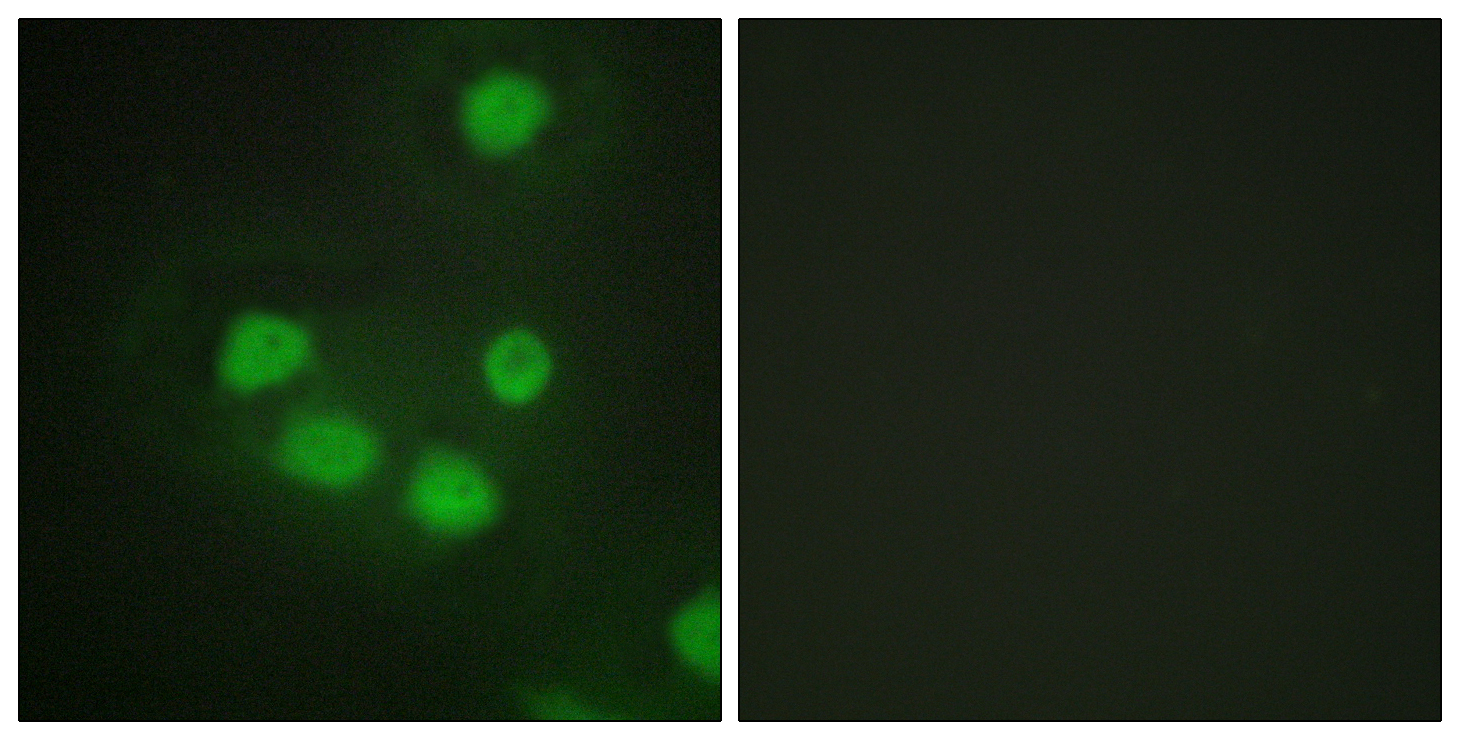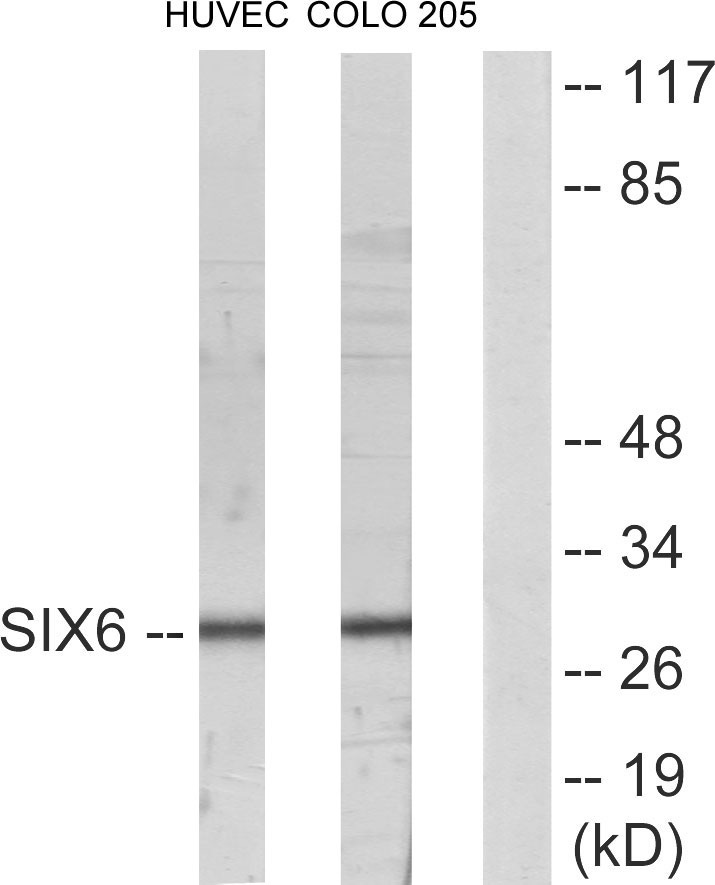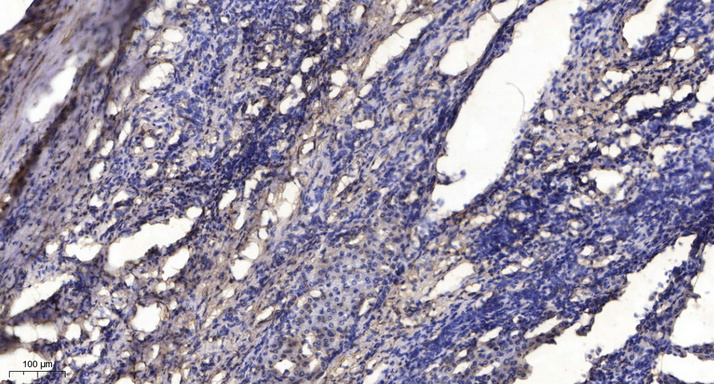Six3/6 Polyclonal Antibody
- Catalog No.:YT4307
- Applications:WB;ELISA;IHC
- Reactivity:Human;Mouse;Rat
- Target:
- Six3/6
- Gene Name:
- SIX6
- Protein Name:
- Homeobox protein SIX6
- Human Gene Id:
- 4990
- Human Swiss Prot No:
- O95475
- Mouse Gene Id:
- 20476
- Mouse Swiss Prot No:
- Q9QZ28
- Immunogen:
- The antiserum was produced against synthesized peptide derived from human SIX6. AA range:121-170
- Specificity:
- Six3/6 Polyclonal Antibody detects endogenous levels of Six3/6 protein.
- Formulation:
- Liquid in PBS containing 50% glycerol, 0.5% BSA and 0.02% sodium azide.
- Source:
- Polyclonal, Rabbit,IgG
- Dilution:
- WB 1:500-2000;IHC 1:50-300; ELISA 2000-20000
- Purification:
- The antibody was affinity-purified from rabbit antiserum by affinity-chromatography using epitope-specific immunogen.
- Concentration:
- 1 mg/ml
- Storage Stability:
- -15°C to -25°C/1 year(Do not lower than -25°C)
- Other Name:
- SIX6;OPTX2;SIX9;Homeobox protein SIX6;Homeodomain protein OPTX2;Optic homeobox 2;Sine oculis homeobox homolog 6
- Observed Band(KD):
- 28kD
- Background:
- The protein encoded by this gene is a homeobox protein that is similar to the Drosophila 'sine oculis' gene product. This gene is found in a cluster of related genes on chromosome 14 and is thought to be involved in eye development. Defects in this gene are a cause of isolated microphthalmia with cataract type 2 (MCOPCT2). [provided by RefSeq, Jul 2008],
- Function:
- disease:Defects in SIX6 are the cause of microphthalmia isolated with cataract type 2 (MCOPCT2) [MIM:212550]. Microphthalmia is a clinically heterogeneous disorder of eye formation, ranging from small size of a single eye to complete bilateral absence of ocular tissues. Ocular abnormalities like opacities of the cornea and lens, scaring of the retina and choroid, cataractand other abnormalities like cataract may also be present.,function:May be involved in eye development.,similarity:Belongs to the SIX/Sine oculis homeobox family.,similarity:Contains 1 homeobox DNA-binding domain.,tissue specificity:Expressed in the developing and adult retina. Also expressed in the hypothalamic and the pituitary regions.,
- Subcellular Location:
- Nucleus .
- Expression:
- Expressed in the developing and adult retina. Also expressed in the hypothalamic and the pituitary regions.
- June 19-2018
- WESTERN IMMUNOBLOTTING PROTOCOL
- June 19-2018
- IMMUNOHISTOCHEMISTRY-PARAFFIN PROTOCOL
- June 19-2018
- IMMUNOFLUORESCENCE PROTOCOL
- September 08-2020
- FLOW-CYTOMEYRT-PROTOCOL
- May 20-2022
- Cell-Based ELISA│解您多样本WB检测之困扰
- July 13-2018
- CELL-BASED-ELISA-PROTOCOL-FOR-ACETYL-PROTEIN
- July 13-2018
- CELL-BASED-ELISA-PROTOCOL-FOR-PHOSPHO-PROTEIN
- July 13-2018
- Antibody-FAQs
- Products Images

- Western Blot analysis of various cells using Six3/6 Polyclonal Antibody cells nucleus extracted by Minute TM Cytoplasmic and Nuclear Fractionation kit (SC-003,Inventbiotech,MN,USA).
.jpg)
- Western Blot analysis of COLO205 cells using Six3/6 Polyclonal Antibody cells nucleus extracted by Minute TM Cytoplasmic and Nuclear Fractionation kit (SC-003,Inventbiotech,MN,USA).

- Immunofluorescence analysis of HepG2 cells, using SIX6 Antibody. The picture on the right is blocked with the synthesized peptide.

- Western blot analysis of lysates from HUVEC and COLO205 cells, using SIX6 Antibody. The lane on the right is blocked with the synthesized peptide.

- Immunohistochemical analysis of paraffin-embedded human liver cancer. 1, Antibody was diluted at 1:200(4° overnight). 2, Tris-EDTA,pH9.0 was used for antigen retrieval. 3,Secondary antibody was diluted at 1:200(room temperature, 45min).



